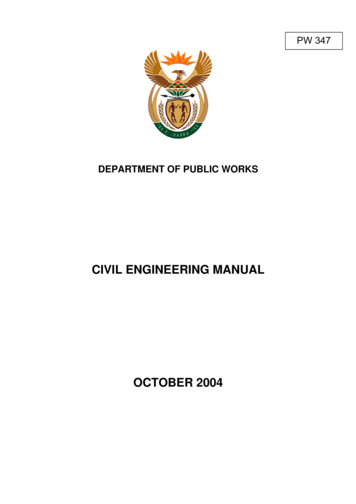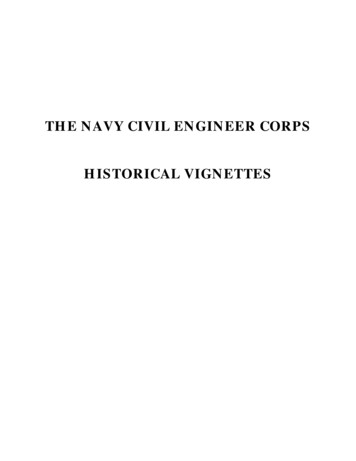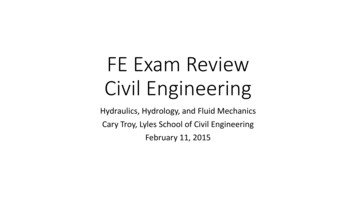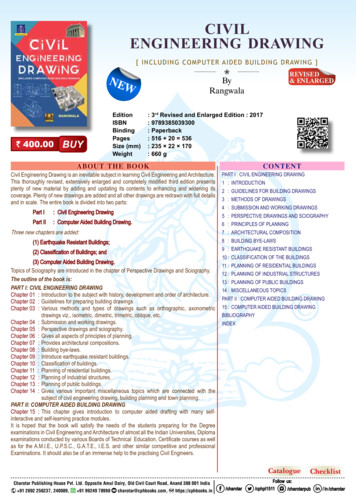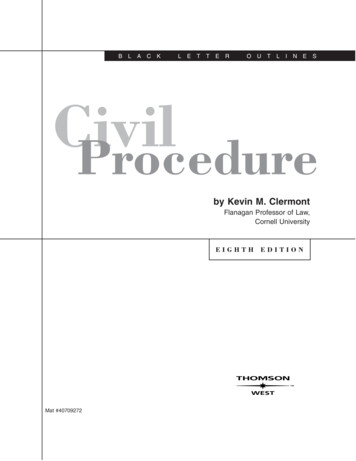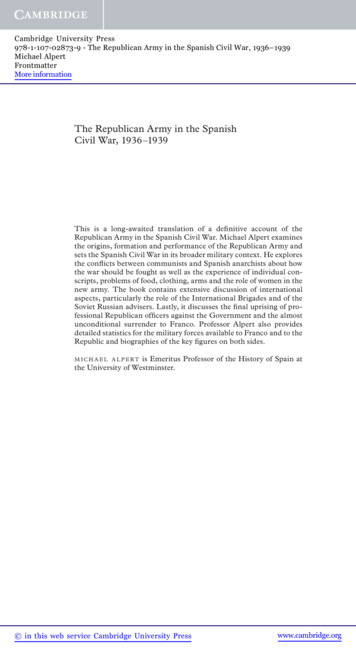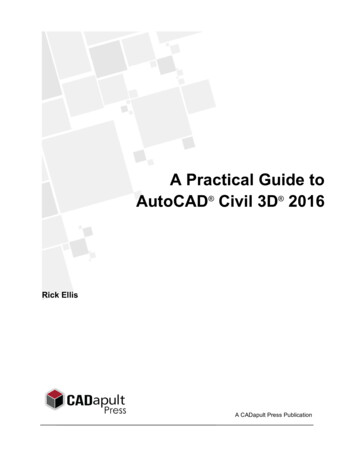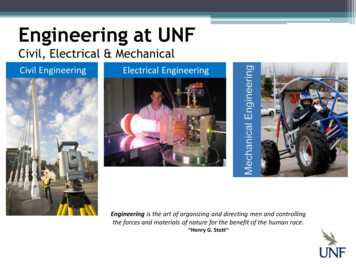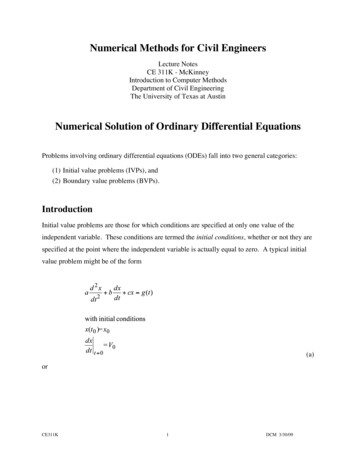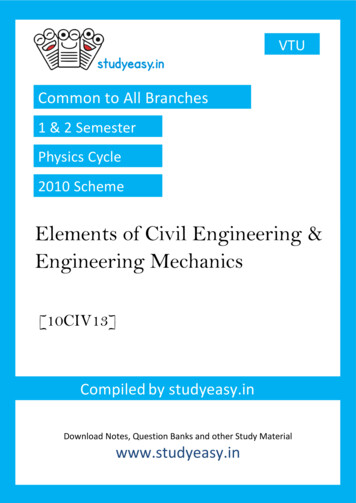
Transcription
VTUCommon to All Branches1 & 2 SemesterPhysics Cycle2010 SchemeElements of Civil Engineering &Engineering Mechanics[10CIV13]Compiled by studyeasy.inDownload Notes, Question Banks and other Study Materialwww.studyeasy.in
Branch Name: Common to all branchesSEM: 1/2University: VTUSyllabus: 2010Table of Contents:Elements of Civil Engg. & Engg. Mechanics (10CIV13):Sl. No.12345678Units(a) Introduction(Building the Future)(b) Roads(c) Bridges & DamsEngineering Mechanics(a) Composition of Forces(b) Coplanar Non-Concurrent ForceSystemsCentroidEquilibrium of ForcesSupports & BeamsFrictionMoment of InertiaDownload notes for other subjects from the link below:www.studyeasy.inT&C - All rights reserved-studyeasy.in - 2014
Compiled by www.studyeasy.inUnit-ICIVIL ENGINEERING – BUILDING THE FUTUREByProf. P. Nanjundaswamy, SJCE, MysoreCivil engineers have one of the world's most important jobs: they build our quality of life.With creativity and technical skill, civil engineers plan, design, construct and operate thefacilities essential to modern life, ranging from bridges and highway systems to watertreatment plants and energy efficient buildings. Civil engineers are problem solvers,meeting the challenges of pollution, traffic congestion, drinking water and energy needs,urban development and community planning.easy.inDuring the past century, clean water supplies have extended general life expectancies.Transportation systems serve as an economic and social engine. New bridges, blendingstrength and beauty, speed transport and bring communities closer together. Public andprivate construction, for which engineers provide the essential underpinnings of designand project oversight, produces hundreds of thousands of jobs and drives communitydevelopment. From the functional and beautiful Golden Gate Bridge in the UnitedStates, Petronas Towers in Malaysia, and Pont du Gard in France to the largely hiddenwater supply and sanitary sewer systems, civil engineers have made their mark in manyaspects of the daily life of essentially everyone around the globe.studyThe American Society of Civil Engineers defines civil engineering as “ the professionin which a knowledge of the mathematical and physical sciences gained by study,experience, and practice is applied with judgment to develop ways to utilize,economically, the materials and forces of nature for the progressive well-being ofhumanity in creating, improving and protecting the environment, in providing facilities forcommunity living, industry and transportation, and in providing structures for the use ofhumanity.”Entrusted by society to create a sustainable world and enhance the global quality of life,civil engineers serve competently, collaboratively, and ethically as master: Planners, designers, constructors, and operators of society’s economic andsocial engine – the built environment Stewards of the natural environment and its resources Innovators and integrators of ideas and technology across the public, private,and academic sectors Managers of risk and uncertainty caused by natural events, accidents, and otherthreats and Leaders in discussions and decisions shaping public environmental andinfrastructure policy.Compiled by www.studyeasy.in
Compiled by www.studyeasy.inworld. Whatever area you choose, be it design, construction, research, planning,teaching or management, civil engineering offers you a wide range of career choices.And there's no limit to the personal satisfaction you will feel from helping to make ourworld a better place to live.Thestudyeasy.inCivil engineering is an umbrella field comprised of many related specialties.following figure shows the broad categories of fields under civil engineering.Building materials technology deals with proper use of desired material for constructioneconomically and safely. Brick, tiles, soil, cement, stone, sand, steel, aggregates, glass,wood, plastics etc. include construction materials. Some are natural and many aremanmade. The mechanical properties of these materials shall be sufficient to avoidfailure and excessive deformation and provide durability. The chemical properties shallbe to maintain good environment.Structural engineers face the challenge of designing structures that support their ownweight and the loads they carry, and that resist extreme forces from wind, earthquakes,bombings, temperature and others. Bridges, buildings, amusement park rides and manyother kinds of projects are included within this speciality. Structural engineers developappropriate combinations of steel, concrete, timber, plastic and new exotic materials.They also plan and design, and visit project sites to make sure work is done properly.Compiled by www.studyeasy.in
Compiled by www.studyeasy.inThe skills of environmental engineers have become increasingly important as weprotect our fragile resources. Environmental engineers translate physical, chemical andbiological processes into systems to destroy toxic substances, remove pollutants fromwater, reduce nonhazardous solid waste volumes, eliminate contaminants from the airand develop groundwater supplies. Environmental engineers are called upon to resolvethe problems of providing safe drinking water, cleaning up contaminated sites withhazardous materials, disposing of wastewater and managing solid wastes.sy.inGeotechnical engineering is required in all aspects of civil engineering because mostprojects are supported by the ground. A geotechnical engineer may develop projectsbelow the ground, such as tunnels, foundations and offshore platforms. They analysethe properties of soil and rock that support and affect the behaviour of these structures.They evaluate potential settlements of buildings, the stability of slopes and fills, theseepage of ground water and the effects of earthquakes. They investigate rocks andsoils at a project site and determine the best way to support a structure in the ground.They also take part in the design and construction of dams, embankments and retainingwalls.udyeaWater is essential to our lives, and water resources engineers deal with the physicalcontrol of water. They work with others to prevent floods, supply water for cities,industry and agriculture, to protect beaches or to manage and redirect rivers. Theydesign, construct and maintain hydroelectric power facilities, canals, dams, pipelines,pumping stations, locks, seaport facilities or even waterslides.stThe quality of a community is directly related to the quality of its transportation system.Transportation engineers work to move people, goods and materials safely andefficiently. They find ways to meet our ever-increasing travel needs on land, air and sea.They design, construct and maintain all types of transportation facilities, includingairports, highways, railroads, mass transit systems and ports. An important part oftransportation engineering is upgrading our transportation capability by improving trafficcontrol and mass transit systems, and by introducing highspeed trains, people moversand other intermodal transportation methods.The construction phase of a project represents the first tangible result of a design. Usingtechnical and management skills, construction engineers turn designs into reality ontime and within budget. They apply their knowledge of construction methods andequipment, along with the principles of financing, planning and managing, to turn thedesigns of other engineers into successful facilities.Planners are concerned with the full development of a community. They analyse avariety of information to co-ordinate projects, such as projecting street patterns,identifying park and recreation areas, and determining areas for industrial andresidential growth. They employ their technical and people skills to co-ordinate withother authorities to integrate freeways, airports and other related facilities.Compiled by www.studyeasy.in
Compiled by www.studyeasy.inInfrastructureIt is the framework of supporting system consisting of transportation, energy,communication, lifeline facilities, irrigation facilities, etc., for the economic developmentof a country by the growth of industrial and agricultural fields. Economic infrastructurecontributes directly to the economic development of the country while socialinfrastructure like education & training, social welfare, housing, water supply, etc., willhave indirect influence on the economic development. Urban growth only can lead topopulation drift from rural sectors leading to explosion in population in cities andinadequate development of villages and improper care for agricultural sector. Use ofinfrastructural facility only by upper class leads to imbalance. Demands for sustainableenergy, fresh water, clean air, and safe waste disposal drive global infrastructuredevelopment.sy.inThe infrastructural development has the following major impacts on a country Increase in food productionProtection from drought, famine, flood Healthy and comfortable housing facility Safe domestic and industrial water supply Safe and scientific waste disposal Improvement in communication and transportation Generation of electricity from, nuclear, hydel, thermal, solar or wind energy Improved, wealth, prosperity, standard of living Overall growth of a nationstudyea Large-scale budget allocation for infrastructure leads to agricultural and industrialdevelopments. It provides employment, eradicates poverty and enhances per capitaincome.Role of Civil engineers in Infrastructural development are Construction of roads, railway, ports, harbors and airports Construction of dams and proper utilization of water resources Construction of Housing, commercial and industrial complexes Maintenance of facilities Rebuilding, Rehabilitation, Retrofitting and RepairConcluding RemarksCompiled by www.studyeasy.in
Compiled by www.studyeasy.in Civil engineers served, serving and will serve as master builders, environmentalstewards, innovators and integrators, managers of risk and uncertainty, andleaders in shaping public policy. Civil Engineering is about community service, development, and improvementstudyeasy.in In essence, Civil Engineering may be regarded as the profession that makes theworld a more agreeable place to live--------------------------Compiled by www.studyeasy.in
Compiled by www.studyeasy.inRoadsTransportation is a non-separable part of any society and is responsible for thedevelopment of civilizations. It meets travel requirement of people and transportrequirement of goods and it is one of the key infrastructures of a country & considered amark of its progress.The roles of transportation in society are:Advancement of communityEconomic prosperity and general development of a countryStrategic movement in emergencySafety, Pollution, Energy consumptionOther impactssy.in Roadways or Highways are one of the primary modes of transportation. Roads providebest bet for achieving inclusive growth of our society than any other modes of transport.Following are the characteristics of roadwayseast Maximum flexibility for travel Route, Direction, Time and Speed Safety decreasesDoor to door serviceFeeder system for other modesUsed by various types of vehiclesFor short distance travel – saves timeRequires relatively small investmentudy India has the second largest road network in the world, next only to USA. However,large stretches of our roads still suffer from deficiencies in road geometry and ridingquality resulting in hazardous conditions and poor road safety. Civil engineers face thechallenge of designing safe highways and at the same time improving the operationalspeeds of the vehicles to reduce the travel time.Classification of RoadsBased on road pavement Paved roads Unpaved roadsBased on use during different seasons All-weather roads Fair-weather roadsBased on traffic volumeCompiled by www.studyeasy.in
Compiled by www.studyeasy.ineasy.in Heavy Medium and Light trafficBased on tonnage Class I, II etc. or Class A, B etc.Based on location and functionNon-Urban Roads – as per Nagpur Road Plan National Highways (NH) State Highways (SH) Major District Roads (MDR) Other District Roads (ODR) Village Roads (VR)Non-Urban Roads – as per third road development plan Primary system – Expressways and NH Secondary system – SH and MDR Tertiary system or rural roads – ODR and VRUrban Roads Arterial roads Sub-arterial roads Collector streets Local streetsstudyComponents of a RoadTypical section of a roadwayA roadway consists of Geometric Elements and Structural Elements. The geometricelements are the visible elements across the roadway while the various layers in thecarriage way constitute the structural elements. The geometric elements include Crosssection Elements, Sight distance considerations, Horizontal and Vertical alignmentdetails, and Intersection elements. The structural elements consist of typical layers ofvarying thicknesses and materials. The common layers in a roadway are: SoilSubgrade, Sub-base course, Base course and Surface course.-------------------------Compiled by www.studyeasy.in
Compiled by www.studyeasy.inA bridge is a structure built to span a gorge, valley, road, railroad track, river, body ofwater, or any other physical obstacle. A bridge is designed for trains, pedestrian or roadtraffic, or pipeline or waterway for water transport or barge traffic. A road-rail bridgecarries both road and rail traffic.Types of Bridges Cantilever bridges Arch bridges Suspension bridges Cable-stayed bridges Truss bridgesConcrete Bridge Steel Bridge Timber Bridge Composite Bridgeudy eaBased on Material usedsy.inBased on Action Beam bridgesBased on purposeRoad Bridge Rail Bridge Rail & Road Bridge Pedestrian Bridge Aqueductst Compiled by www.studyeasy.in
Compiled by www.studyeasy.instudyeasy.inBasic Bridge TypesCompiled by www.studyeasy.in
Compiled by www.studyeasy.inudyeasy.inCulvertsCulverts are smaller bridges, normally with one span built across small streams, drainsor sewer carrying road on topBridge ComponentsFoundation Abutment Bridge Pier Bearing Deck Slab Roadway Railingst References1) ASCE (2007), The Vision for Civil Engineering in 2025, American Society of CivilEngineers2) Syed Shakeeb Ur Rahman and Madhava Rao V (2006), Elements of CivilEngineering and Engineering Mechanics, Sanguine Technical Publishers.--------------------------Compiled by www.studyeasy.in
Compiled by www.studyeasy.inUnit-IIENGINEERING MECHANICSBy Prof. V. Madhava Rao, SJCE, MysoreMECHANICSIt’s a branch of science, which deals with the action of forces on bodies at rest orin motion.ENGINEERING MECHANICSIt deals with the principles of mechanics as applied to the problems inengineering.sy.inBASIC CONCEPTS1. Matter: Anything which has mass and requires space to occupy is called matter.2. Mass: It is a measure of quality of matter contained by the body.SI unit: Kg.Unit: m3Note: Liter Unit of volumeudy1000 liters 1 m3ea3. Volume: It is a measure of space occupied by the body.TMS – Thousand million cubic feet. 109 ft3st 10009 ft x 10000 ft x 1000 ft4. State of rest and motion: State of rest and state of motion are relative and dependon the frame of reference. A body is said to be in a state of rest w.r.t. a frame ofreference if the position of the body w.r.t. that frame of reference is not changingwith time. A body is laid to be in a state of motion w.r.t. a frame of reference if theposition of the body w.r.t. that frame of reference is changing with time.5. Scalar and Vector Quantities: Quantities which require only magnitude torepresent them are called scalar quantities.Eg: Mass, Time interval.Quantitites which require both magnitude and direction to represent them are calledvector quantities.Eg: Force, Velocity, etc.Compiled by www.studyeasy.in
Compiled by www.studyeasy.in6. Displacement and distance travelled: The total linear movement made by a bodyto change its position from one point to another is called distance travelled by thebody. It is a scalar quantity.Unit: Meter (m)mm – Millimeter 10-3mBDisplacementkm – Kilo Meter 103mThe total linear movement made by abody to change its position from one Apoint to another moving along a particularDistancedirection is called displacement.Displacement is a vector quantity.sy.inUnit: Meter (m).7. Speed and Velocity: The distance travelled in a unit time is speed.Unit: m/s ms-1The displacement in unit time is called velocity.eaUnit: m/s ms-18. Uniform motion and non-uniform motion: If the velocity of the moving bodyudyremains constant then the motion is said to be uniform. If the velocity is changingwith time, the motion is laid to be non-uniform.9. Acceleration and retardation: The time rate of change of velocity is calledacceleration.stIf the velocity is increasing with time then acceleration is positive. If the velocity isdecreasing with time then acceleration is negative. Negative acceleration is calledretardation or deceleration.Unit: m/s2 ms-210. Momentum: It is the capacity of a moving body to impart motion to other bodies.Momentum of a moving body is given by the product of mass and velocity of themoving body.Momentum Mass X VelocityUnit: kg m/s or kg ms-1.11. Newton’s I Law of Motion: “Everybody continues to be in its state of rest or uniformmotion unless compelled by an external agency”.Compiled by www.studyeasy.in
Compiled by www.studyeasy.in12. Inertia: It is the inherent property of a body by virtue of which it can retain its state ofrest or uniform motion unless compelled by an external agency.13. Force: It is an external agency, which overcomes or tends to overcome the inertia ofa body. It is a vector quantity.14. Elements of a force: There are four elements:a. Magnitudeb. Directionc. Line of actiond. Point of action or application15. Newton’s II Law of motion: “The rate of change of moment of a body is directlyproportional to the magnitude of the force applied and takes place in the direction ofsy.inthe force applied”.Explanation:Initial momentum muFinal momentum mveaChange in momentum over a time interval ‘t’ mv – muRate of change of momentum mv mutFαmv mutudyAccording to Newton’s II law,mFst v u F α m t umVTime interval tF α maF K maIn SI, unit force is defined as that force which acts on a body of unit mass producingunit acceleration.i.e., F 1 when m 1 and a 1then 1 k . 1 . 1 k 1F maUnit of force: newton (N) is the unit of force. One newton is that force which acts ona body of mass 1 kg producing an acceleration of 1 m/s2.Compiled by www.studyeasy.in
Compiled by www.studyeasy.inkN– Kilo newton – 103NMN– Mega newton – 106NGN– Giga newton – 109N16. Newton’s III law of motion: “For every action there is equal and opposite reaction”.17. Branches of Mechanics:MechanicsFluid idDynamicseaMech. ofDeformableBodiesudyRigidBodyMech.sy.inSolid Mech.KinematicsKineticsstStatics: Statics deals with the action of forces on bodies at rest or in equilibrium.Dynamics: Dynamics deals with the action of forces on bodies in motion.Kinematics: It deals with the study of geometry of motion without considering thecause of motion.Kinetics: Kinetics deals with a study of motion considering the course of motion.18. Rigid body: The concept of rigid body is purely theoretical or imaginary. A rigid bodyis said to undergo, no deformation under the action of any external agency such asforce and moments.In other words relative positions of the modules of a rigid body are fixed in space.19. Particle: Concept of particle is purely theoretical or imaginary. A particle is said tohave mass but requires no space to occupy. In other words, a particle is a pointmass.Compiled by www.studyeasy.in
Compiled by www.studyeasy.inThe concept of particle cannot be used if the shape and size of the body isinfluencing the motion.Eg:i) Motion of a swimmer.ii) Motion of a body along a curved path.20. Continuum: The concept of continuum is purely theoretical or imaginary.Continuum is said to be made up of infinite number of molecules packed in such away that, there is no gap between the molecules so that property functions remainsame at all the points.21. Point force: The concept of point force in purely theoretical or imaginary, here theforce is assumed to be acting at a point or over infinity small area.F1F1udyF2MF2MMa1a2a1, a2a1, a2stF1MeaF1sy.in22. Principle physical independence of forces:Action of forces on bodies are independent, in other words the action of forces on abody is not influenced by the action of any other force on the body.23. Principle of superposition of forces:Compiled by www.studyeasy.in
Compiled by www.studyeasy.inMF1MF1F2F1F1F2a1a2M(a1 a2)M(a2 a1)Net effect of forces applied in any sequence on a body is given by the algebraic sumsy.inof effect of individual forces on the body.24. Principle of transmissibility of forces:eaMa FMA Rigid bodyFudyLine of actiona FMLine of actionMBFstRigid bodyThe point of application of a force on a rigid body can be changed along the sameline of action maintaining the same magnitude and direction without affecting theeffect of the force on the body.Limitation of principle of transmissibility: Principle of transmissibility can be usedonly for rigid bodies and cannot be used for deformable bodies.25. Assumptions made in Engineering Mechanicsi) All bodies are rigid.ii) Particle concept can be used wherever applicable.iii) Principle of physical independence of forces is valid.iv) Principle of superposition of forces is valid.v) Principle of transmissibility of forces is valid.Compiled by www.studyeasy.in
Compiled by www.studyeasy.inSYSTEM OF FORCESA group or set of forces is called system of forces.Types:1. Coplanar force system:F1F2F3If the lines of action of forces forming the system lie in the same plane, then thesystem is said to be coplanar.sy.in2. Non-coplanar forces:F1F2F4 F6eaF5F3udyIf the lines of action of forces forming the system do not lie in the same plane thenthe system is said to be non-coplanar.Note: Our study is restricted to coplanar forces.3. Collinear force system:stF1AF2F3BCIf the forces forming the system have common line of action then the system is saidto be collinear.Compiled by www.studyeasy.in
Compiled by www.studyeasy.in4. Concurrent force system:xDxAF4F10F2BCF1F3F3F4F2F2OOF4F3F1sy.inIf the line of action of forces forming the system pass through a common point (pointof concurrence) then the system is said to be concurrent.5. Non-concurrent force system:eaF1F4F2F3udyIf the lines of action of forces forming the system do not pass through a commonpoint, then the system is said to be non-concurrent.st6. Parallel force system:F1F2F2F3F4LikeF1F4F3UnlikeIt is a particular case of non-concurrent force system in which the line of action offorces forming the system are parallel.RESOLUTION OF A FORCEYCompiled by www.studyeasy.in
Compiled by www.studyeasy.inY DisplacementXFX DisplacementThe force F is producing, simultaneous x displacement and y-displacement. Thepart of the force F which is producing x displacement is called x component orhorizontal component of the force F (Fx). The part of the force F which produces y –sy.indisplacement is called y component of the force or vertical component of force F (Fy).The technique of finding a component of a force along any direction is calledresolution of force. The component of a force along any direction is called the resolvedcomponent. The components of a force determined along two mutually perpendiculareadirection are called rectangular components.To resolve a force along any directionudyYAstA2FyFθFXA1XOA represents the force F both in magnitude and direction ‘θ’ is the acute anglemode by the force w.r.t. x direction.We have,Cos θ Cos θ OA 1OAFxFFx F Cos θSin θ AA 1OASin θ AA 2OA( )Compiled by www.studyeasy.in
Compiled by www.studyeasy.inSin θ FyF( )Fy F Sin θX component of a force is given by the product of magnitude of the force andcosine of acute angle made by the force w.r.t. x-direction.Y component of a force is given by the product of magnitude of the force andsine of acute angle made by the force w.r.t. x-direction.Note:sy.in1. Sign convention for the direction of components. 2. θ 0Fx F Cos O –st Fudyea–Fy F Sin O OThe horizontal component or ‘X’ component of a force acting along x direction is theforce itself. Whereas, its vertical component or y-component is zero.3.Fx F Cos 90 OFy F Sin 90 F‘x’ component of a force acting along Y direction is zero. Whereas, its ‘y’ componentis equal to itself.Compiled by www.studyeasy.in
Compiled by www.studyeasy.in4. If a force is inclined at 45o w.r.t. x axis or y axis then its x component will be equal toy component (Fx Fy).Problems1. Find X and Y components of forces in the following cases.a)100 kNFx 100 Cos 3030o 86 . 60 kN 86 . 60 kN ( )Fy 100 Sin 30sy.in 50 . 00 kN 50 . 00 kN ( )b)20 kNFx 20 Cos 70ea30o 6 . 840 kNudy 6 . 840 kN ( )Fy 20 Sin 70 18 . 79 kNst 18 . 79 kN ( )c)Method-Itan θ 4334θ 36.87 o200 NFx - 200 Cos 36.87o – 160 N 160 N( )Compiled by www.studyeasy.in
Compiled by www.studyeasy.inFy - 200 Cos 36.87o – 120 N 120 N( )Method-IICos θ Sin θ 4 0.853 0.65Fx - 200 Cos θ 160 N( )Fy – 200 Sin θ – 200 x 0.6 – 120 N( )study 120 Nea – 160 Nsy.in – 200 x 0.8Compiled by www.studyeasy.in
Compiled by www.studyeasy.inRESULTANT FORCE OF A SYSTEM OF FORCESαF1F2F3F4αRsy.inThe resultant of a system of forces is a single calculated force which is capableof producing the same effect as that of system of forces on the body. It is the vectorsum of forces of the system.eaCOMPOSITION OF FORCESThe technique of finding the resultant of forces is called composition of forces.udyMOMENT OF A FORCEIt is the capacity of a force to produce rotator motion. In other words moment of aforce is its rotating capacity.FstAMoment of F about A inclockwiseFAMoment of F about A inanticlockwiseBased on the direction of rotation produced moment of a force can be classifiedintoa) Clockwise momentb) Anticlockwise moment / counter clockwise moment.Compiled by www.studyeasy.in
Compiled by www.studyeasy.inCalculation of Moment of a Force about a PointMoment of a force about any point is given by the product of magnitude of forceand perpendicular distance between the line of action of a force and the point aboutwhich moment is considered.XMA FLUnit: NmFsy.inSign Convention for Moment of a ForceClockwise moment positive and anticlockwise moment negative.1) Find moment of force ‘F’ about ‘A’ in the following cases.a)eaF 10 kNstb)XAudy2mXAF 10 kN2mc)3mXF 20 kNCompiled by www.studyeasy.inA
Compiled by www.studyeasy.ind)2mA50 kN2) Find moment of the force about A and B in the followinga)2msy.inXAXB4meaF 10 kNF 20 kNB3mA4mstudyb)Compiled by www.studyeasy.in
Compiled by www.studyeasy.inUnit-IIIELEMENTS OF CIVIL ENGINEERING ANDENGINEERING MECHANICSbyProf. Karisiddappa, MCE, HassanCOMPOSITION OF FORCES: The reduction of a given system of forcesto the simplest system that will be its equivalent is called the problem ofcomposition of forces.easy.in RESULTANT FORCE: It is possible to find a single force whichwill have the same effect as that of a number of forces acting on abody. Such a single force is called resultant force. The process of finding out the resultant force is called composition offorces.udyCOMPOSITION OF CO-PLANAR CONCURRENT FORCE SYSTEMstCOMPOSITION OF TWO FORCES: It is possible to reduce a givensystem of forces i.e., two forces to the simplest system as its equivalent(resultant force) with the help of parallelogram law of forces. LAW OF PARALLELOGRAM OF FORCES:If two forces, which act at a point be represented in magnitude anddirection by the two adjacent sides of a parallelogram drawn from one of itsangular points, their resultant is represented by the diagonal of theparallelogram passing through that angular point, in magnitude anddirection.Compiled by www.studyeasy.in
Compiled by www.studyeasy.inCBRRRαOsy.inθR F1 2 F 22 2 F1 F 2 cos αstudyeaACompiled by www.studyeasy.in
Compiled by nsider two forces F1 and F2 acting at point O as shown infigure. Let α be the angle between the two forces.Complete the parallelogram ACBO .Drop perpendicular CD toOA produced. Let R be the resultant force of forces and.Let θ be the inclination of the resultant force with theline of action of the force.Compiled by www.studyeasy.in
Compiled by www.studyeasy.inFrom triangle OCD,OC 2 OD 2 CD 2OC 2 (OA AD ) 2 CD 2OA F1 , AD F2 cos α , CD F2 sin α , OC RR 2 ( F1 F2 cos α ) 2 ( F2 sin α ) 222R 2 F12 2 F1 F2 cos α F2 cos 2 α F2 sin 2 α2sy.inR 2 F1 2 F1 F2 cos α F22R F12 F22 2 F1 F2 cos αCDODF2 sin αtan θ F1 F2 cos αeatan θ F2 sin α cosαFF 12 studyθ tan 1 Compiled by www.studyeasy.in
Compiled by www.studyeasy.inIFRF20α 90 , R F1 F2F10IFα 0 , R F1 F2IFα 1800 , R F1 F2F1F2TRIANGLE LAW OF FORCES:udyeaIf two forces acting simultaneously on a body arerepresented by the sides of a triangle taken in order,their resultant is represented by the closing side ofthe triangle taken in the opposite order.st F2sy.inF1BF2RF2OAOF1Compiled by www.studyeasy.inF1
Compiled by www.studyeasy.in POLYGON LAW OF FORCES:If a number of concurrent forces acting simultaneously on a body ,arerepresented in magnitude and direction by the sides of a polygon,taken in order , then the resultant is represented in magnitude anddirection by the closing side of the polygon, taken in opposite order.CF4DF2sy.inF3F3R2ROBR1OF1F1F2AudyeaF4 stCOMPOSITON OF FORCES BYRESOLUTION(Principle of resolved parts)The components of each force in the system in two mutuallyperpendicular directions are found.Then, the components in each direction are algebraicallyadded to obtain the tw
Civil engineering is an umbrella field comprised of many related specialties. The following figure shows the broad categories of fields under civil engineering. Building materials technology deals with proper use of desired material for construction economically and safely. Brick, ti

